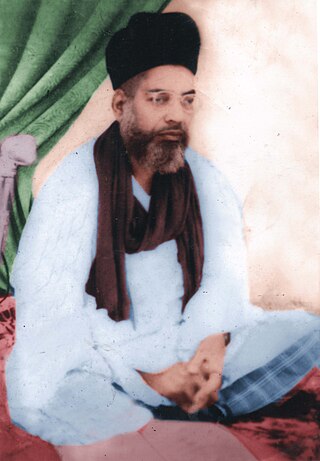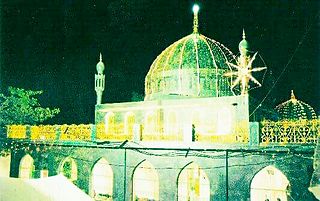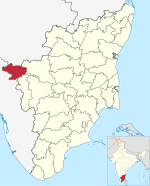Related Research Articles

Ooty, abbreviated as Udhagai) is a town and municipality in the Nilgiris district of the Indian state of Tamil Nadu, 86 km (53 mi) north west of Coimbatore, and the headquarters of the Nilgiris district. In the Nilgiri hills, it is known as the "Queen of Hill Stations" and is a popular tourist destination.

The Nilgiris district is one of the 38 districts in the southern Indian state of Tamil Nadu. Nilgiri is the name given to a range of mountains spread across the borders among the states of Tamil Nadu, Karnataka and Kerala. The Nilgiri Hills are part of a larger mountain chain known as the Western Ghats. Their highest point is the mountain of Doddabetta, height 2,637 m. The district is contained mainly within the Nilgiri Mountains range. The administrative headquarters is located at Ooty. The district is bounded by Coimbatore to the south, Erode to the east, and Chamarajnagar district of Karnataka and Wayanad district of Kerala to the north. As it is located at the junction of three states, namely, Tamil Nadu, Kerala, and Karnataka, significant Malayali and Kannadiga populations reside in the district. Nilgiris district is known for natural mines of Gold, which is also seen in the other parts of Nilgiri Biosphere Reserve extended in the neighbouring states of Karnataka and Kerala too.

A dargah is a shrine or tomb built over the grave of a revered religious figure, often a Sufi saint or dervish. Sufis often visit the shrine for ziyarat, a term associated with religious visitation and pilgrimages. Dargahs are often associated with Sufi eating and meeting rooms and hostels, called khanqah or hospices. They usually include a mosque, meeting rooms, Islamic religious schools (madrassas), residences for a teacher or caretaker, hospitals, and other buildings for community purposes.

Doddabetta is the highest mountain in the Nilgiri Mountains at 2,637 metres (8,652 ft). There is a reserved forest area around the peak. It is 9 km from Ooty, on the Ooty-Kotagiri Road in the Nilgiris District of Tamil Nadu, India. It is a popular tourist attraction with road access to the summit. It is the fourth highest peak in South India next to Anamudi, Mannamalai and Meesapulimala. The peaks Hecuba, Kattadadu and Kulkudi are the three closely linked summits in the west of the Doddabetta range near to Udagamandalam. The word Doddabetta is derived from Kannada language meaning big hill.

Baba Budangiri, also known as Chandradrona, is a hill and mountain range in the Western Ghats of India, located in the Chikkamagaluru district of Karnataka.

Hazrat Nizamuddin Dargah is the dargah (mausoleum) of the Sufi saint Khwaja Nizamuddin Auliya. Situated in the Nizamuddin West area of Delhi, the dargah is visited by thousands of pilgrims every week. The site is also known for its evening qawwali devotional music sessions.
Islampur is a city and Notified area in Nalanda district in the Indian state of Bihar. it is a city council and no of ward is 26 here.

Pykara is a river 19 kilometres (12 mi) from Ooty in the Indian State of Tamil Nadu with a village by the same name nearby. The Pykara River is considered very sacred by the Todas. It rises at Mukurthi peak, flows northwards, and then turns to the west after reaching the edge of the plateau. The river flows through Mukurthi, Pykara and Glenmorgan dams, and forms part of an important hydro-electric power project.
Huvina Hipparagi also Huvin Hipparagi is a Town in the southern state of Karnataka, India. It is located in the Basavana Bagevadi taluk of Vijayapura district in Karnataka.

Sheikh Noor Ul Mashaikh Sayyid Ahmed Muhiyuddin Jeelani NooriShah Arabic:, known more commonly as NooriShah Jeelani, was a renowned 20th-century muslim, sufi, wali, mystic, orator, faqeeh, theologian, mujaddid and highly acclaimed Islamic scholar of the Qadri, Chisti order from the Indian sub continent. He was the 21st grand son of the famous Sufi saint Ghous-e-Azam Sheikh Mohiyudheen Abdul Qadir Jilani of Baghdad. He was also widely known by his title Noor-ul-Mashaikh. He was the Eponymous founder of the Silsila-e-Nooriya tariqa which is a sub-branch of Qadiriyya and Chistiyya in India.
Khwaja Habib Ali Shah was an Indian Sufi saint, whose lineage is traced back to Abu Bakr, the first Caliph of Islam.

Ooty lake is an artificial lake near Ooty in the Nilgiris district of Tamil Nadu, India. It covers an area of 26 hectares. The boathouse on the lake is a major tourist attraction.
Dargah Yousufain also known as Yousuf Baba Sharif Baba Dargah is a dargah in Hyderabad, India, where two Muslim Sufi Saints named Syed Shah Yousufuddin and Syed Shah Sharifuddin are buried.

Ghousi Shah was a Muslim Sufi saint and poet from the Indian subcontinent. He was born on 1 July 1893 CE in Hyderabad, corresponding to 16 Dhulhijja 1310 AH.

Western Catchment is an area of The Nilgiris, Tamil Nadu, situated about 20 km from Ooty. The Western Catchment area is protected by the Forest Department, and tourists are not allowed in without permission. Earlier some regional movies were filmed here, but due to environmental protection permission is no longer given.

Syed Shah Afzal Biabani was a Sufi from Warangal, Hyderabad State. He was appointed as Kazi of Warangal during the reign of Nizam Ali Khan. His dargah is among the pilgrimage centers of Warangal, Telangana.

Nagore Dargah is a dargah built over the tomb of the Sufi saint Shahul Hameed. It is located in Nagore, a coastal town in the South Indian state of Tamil Nadu. The outer doors of the dargah are kept open always, while the internal doors are open from 4:00 am to 06:00 am and from 6:00 pm to 10:00 pm. On Fridays, the doors are additionally kept open between 12:00 pm and 2:30 pm. Shahul Hamid is believed to have performed many miracles in Nagore, and cured the physical affliction of king Achuthappa Nayak, a 16th-century Hindu ruler of Thanjavur. He is locally referred to as Nagore Andavar, meaning the "Ruler of Nagore" and Qadir wali baba. Nagore dargah as it stands now, is believed to have been built by ardent devotees of Shahul Hamid, with major contribution from Hindus. There are five minarets in the dargah, with the Hindu Maratha ruler of Thanjavur Pratap Singh, building the tallest minaret. The dargah is a major pilgrimage centre that attracts pilgrims from both sufi Islam and Hinduism, symbolizing peaceful coexistence between the two religions.

Ajmer Sharif Dargah is a Sufi Tomb (dargah) of the Sufi saint, Khawaja Moinuddin Chishti, located at Ajmer Shareef, Rajasthan, India.

The Shah Jalal Dargah is the shrine and burial place of the 14th century Muslim saint Shah Jalal, located in Sylhet, Bangladesh. The site, known as a dargah, was originally constructed c. 1500, though many additions and alterations were made to its structures over the following centuries. It became a religious centre in the region, respected across multiple ruling administrations and greatly venerated among Bengalis, with local folklore and legends developing around it. The extensive surrounding compound serves several functions and includes four mosques, a religious school and a public cemetery among others. The Dargah is presently the largest and most visited religious site in Bangladesh.
References
- ↑ "Panther found dead in Ooty". The Times of India . Archived from the original on 10 September 2012. Retrieved 15 September 2011.
- 1 2 Radhakrishnan, D. (4 February 2008). "Concern over abuse of Shola reservoir area by vandals". The Hindu . Archived from the original on 7 February 2008. Retrieved 15 September 2011.
- ↑ "Devotees throng Gori Shola shrine". The Hindu . 28 April 2009. Archived from the original on 2 May 2009. Retrieved 15 September 2011.
- ↑ "Milad-un-Nabi celebrated with religious fervour in Ooty". The Hindu . 17 February 2011. Archived from the original on 8 May 2011. Retrieved 15 September 2011.
- ↑ "Concern over abuse of Shola reservoir area by vandals". The National Law School of India University. Archived from the original on 24 March 2012. Retrieved 15 September 2011.





